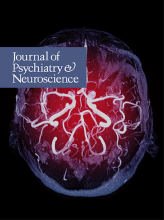
Chaos analysis of the cortical boundary for the recognition of psychosis
Alexandra I. Korda, Christina Andreou, Mihai Avram, Marina Frisman, …, Stefan Borgwardt
2023, J Psychiatry Neurosci
DOI: https://doi.org/10.1503/jpn.220160
Abstract
Background: Structural MRI studies in people with first-episode psychosis (FEP) and those in the clinical high-risk (CHR) state have consistently shown volumetric abnormalities that depict changes in the structural complexity of the cortical boundary. The aim of the present study was to employ chaos analysis in the identification of people with psychosis based on the structural complexity of the cortical boundary and subcortical areas.
Methods: We performed chaos analysis of the grey matter distribution on structural MRIs. First, the outer boundary points for each slice in the axial, coronal and sagittal view were calculated for grey matter maps. Next, the distance of each boundary point from the centre of mass in the grey matter was calculated and stored as spatial series, which was further analyzed by extracting the Largest Lyapunov Exponent (lambda [λ]), a feature depicting the structural complexity of the cortical boundary.
Results: Structural MRIs were acquired from 77 FEP, 73 CHR and 44 healthy controls. We compared λ brain maps between groups, which resulted in statistically significant differences in all comparisons. By matching the λ values extracted in axial view with the Morlet wavelet, differences on the surface relief are observed between groups.
Limitations: Parameters were selected after experimentation on the examined sample. Investigation of the effectiveness of the method in a larger data set is needed.
Conclusion: The proposed framework using spatial series verifies diagnosis-relevant features and may contribute to the identification of structural biomarkers for psychosis.